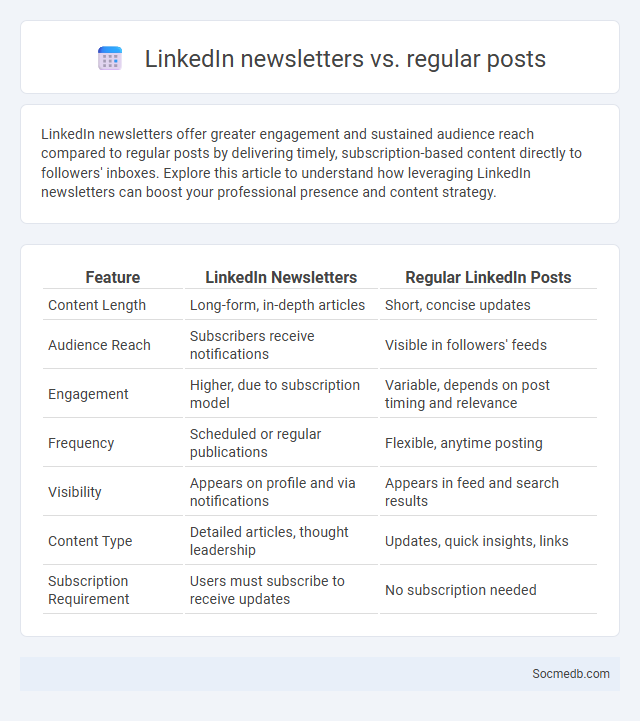
Photo illustration: LinkedIn newsletters vs regular posts
LinkedIn newsletters offer greater engagement and sustained audience reach compared to regular posts by delivering timely, subscription-based content directly to followers' inboxes. Explore this article to understand how leveraging LinkedIn newsletters can boost your professional presence and content strategy.
Table of Comparison
| Feature | LinkedIn Newsletters | Regular LinkedIn Posts |
|---|---|---|
| Content Length | Long-form, in-depth articles | Short, concise updates |
| Audience Reach | Subscribers receive notifications | Visible in followers' feeds |
| Engagement | Higher, due to subscription model | Variable, depends on post timing and relevance |
| Frequency | Scheduled or regular publications | Flexible, anytime posting |
| Visibility | Appears on profile and via notifications | Appears in feed and search results |
| Content Type | Detailed articles, thought leadership | Updates, quick insights, links |
| Subscription Requirement | Users must subscribe to receive updates | No subscription needed |
Understanding LinkedIn Newsletters
LinkedIn Newsletters enable professionals to distribute targeted content directly to their network, enhancing engagement through regular updates and industry insights. These newsletters leverage LinkedIn's algorithm to increase visibility, fostering thought leadership and community growth. Optimizing headline keywords and consistency in publishing significantly boost subscriber retention and interaction rates.
Regular LinkedIn Posts: An Overview
Regular LinkedIn posts drive consistent engagement by sharing industry insights, company updates, and professional achievements, enhancing brand visibility and networking opportunities. Optimizing post timing and using relevant hashtags increase reach and interaction among target audiences. Incorporating multimedia elements like images, videos, and infographics further boosts user attention and content impact on LinkedIn feeds.
What Is a LinkedIn Content Strategy?
A LinkedIn content strategy involves creating and sharing targeted, relevant content to engage your professional network and enhance your brand presence on the platform. It focuses on aligning your posts, articles, and interactions with the interests and needs of your industry audience to drive meaningful connections and business opportunities. By implementing a clear LinkedIn content strategy, you can effectively position Your expertise and grow Your influence within your professional community.
Audience Reach: Newsletters vs Posts
Newsletters offer targeted audience reach by delivering personalized content directly to subscribers' inboxes, ensuring higher engagement rates among interested users. Social media posts can reach broader and more diverse audiences quickly, but often face algorithmic limitations that reduce organic visibility. To optimize your marketing strategy, balance newsletters' direct connection with the wide but less predictable reach of posts.
Engagement Rates Compared
Engagement rates on social media vary significantly across platforms, with Instagram often leading at an average of 1.22%, compared to Facebook's 0.08% and Twitter's 0.045%, highlighting Instagram's superior interaction levels. Video content, especially on TikTok, drives engagement rates up to 5-6%, outperforming static posts across networks by a substantial margin. Brands targeting higher engagement should prioritize platform-specific content strategies based on these benchmarks to maximize user interaction and conversion.
Frequency and Consistency Best Practices
Posting consistently on social media platforms significantly boosts audience engagement and brand visibility, with top-performing brands posting 1-2 times per day on Instagram and 3-5 times per week on Facebook. Maintaining a regular schedule using content calendars ensures steady interaction and helps algorithms favor your content. High-frequency posting tailored to each platform's peak engagement times enhances reach without overwhelming followers, optimizing overall social media strategy effectiveness.
Content Format and Depth Differences
Social media content varies widely in format and depth, ranging from brief tweets and image posts to in-depth articles and video tutorials. Your choice of platform influences content style, as Instagram prioritizes visual and succinct posts while LinkedIn supports longer, professional insights. Understanding these distinctions helps tailor your message effectively to engage your audience across different channels.
Building Authority: Which Drives More Credibility?
Building authority on social media enhances credibility by consistently sharing expert insights, engaging with industry leaders, and providing valuable content tailored to your audience's needs. Platforms like LinkedIn and Twitter are particularly effective for establishing thought leadership through regular posts, comments, and collaborations with influencers. Establishing a strong, authoritative presence increases trust, drives follower growth, and positions your brand as a go-to resource in your niche.
Analytics and Performance Tracking
Social media analytics involves the collection and analysis of data from platforms to measure content reach, engagement, and audience behavior. Performance tracking tools provide insights into key metrics such as click-through rates, conversion rates, and follower growth, enabling data-driven marketing strategies. Leveraging real-time dashboards and AI-driven analytics enhances the accuracy of campaign optimization and ROI measurement.
Choosing the Right Mix for Your LinkedIn Growth
Selecting the optimal combination of content types and engagement strategies is essential for driving LinkedIn growth and expanding your professional network. Prioritize sharing industry-relevant articles, insightful posts, and interactive media such as polls or videos to maximize visibility and foster meaningful connections. Tailoring your approach based on analytics data helps ensure your LinkedIn presence aligns with your specific audience's preferences and professional interests.
 socmedb.com
socmedb.com